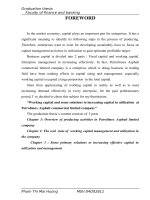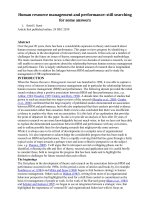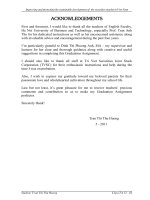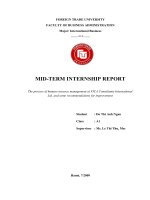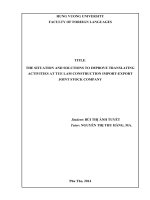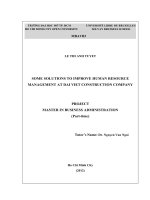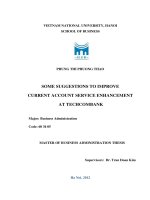Some solutions to improve human resource management at Dai Viet construction company
Bạn đang xem bản rút gọn của tài liệu. Xem và tải ngay bản đầy đủ của tài liệu tại đây (563.49 KB, 86 trang )
i
TRệễỉNG ẹAẽI HOẽC Mễ TP. HCM UNIVERSITE LIBRE DE BRUXELLES
HO CHI MINH CITY OPEN UNIVERSITY SOLVAY BRUSSELS SCHOOL
MBAVB3
LE THI ANH TUYET
SOME SOLUTIONS TO IMPROVE HUMAN RESOURCE
MANAGEMENT AT DAI VIET CONSTRUCTION COMPANY
PROJECT
MASTER IN BUSINESS ADMINISTRATION
(Part-time)
Tutors Name: Dr. Nguyen Van Ngai
Ho Chi Minh City
(2012)
ii
UNDERTAKINGS
I hereby certify that I have myself studied this research applied the academic
knowledge gained from the MBA course and through the discussions with my
professors
The project has been conducted based on the real information and context of Dai
Viet Construction Company who is the case study in this project.
I undertake that this is my own research project, all information, data and survey
results are true and never announced in any other research projects.
Ho Chi Minh City, March 2012
Le Thi Anh Tuyet
iii
ACKNOWLEDGEMENT
First of all, I would like to express my deepest and sincerest gratitude to my
tutor Dr. Nguyen Van Ngai for his invaluable guidance, suggestion and
encouragement to complete this research study.
Many thanks are also extended to the director and all managers and staffs of
Dai Viet Construction Company for their generous support and help during the time
of data collection for completing this project.
My grateful acknowledgement is extending to the Universiteù Libre De
Bruxelles-Solvay Business School and Open University Of HCMC, which provided
me a chance to follow this Part time MBA program.
In addition, I am delighted to express my gratitude for all the faculty
members and staff at Open University, and Board of Coordinator for their support.
Also I am indebted to all of my classmates, especially to my group 05 who
supported me during my study at HCMC-OU.
Finally, my delighted gratitude is for my family who are always my endless
backing and inspiration for me to overcome the challenge during the study.
v
TABLE OF CONTENTS
List of Abbreviations vii
List of Charts viii
List of Tables ix
CHAPTER I. INTRODUCTION 1
1.1 Background 1
1.2 Rationale Of The Study 1
1.3 Problem Statement 2
1.4 Objectives Of The Study 2
1.5 Research Methodology 2
1.6 Scope Of The Study 3
1.7 Structure 3
CHAPTER 2. LITERATURE REVIEW 6
2.1 Human Resource Planning 6
2.2 Job Description: 7
2.3 Human Resource Recruitment and Selection 7
2.4 Training and People Development 11
2.5 Performance Appraisal System 12
2.6 Employee Motivation 13
2.7 Workflow 15
2.8 Compensation and Benefit 15
CHAPTER 3. HUMAN RESOURCE MANAGEMENT PRACTICE IN DAI VIET 16
3.1 Construction Industry Overview 17
3.2 Background of Dai Viet 19
3.3 Human Resource at Dai Viet
24
CHAPTER 4. FINDINGS AND DATA ANALYSIS 27
4.1 Profile of Respondents 27
4.1.1.Age 27
4.1.2.Gender 28
vi
4.1.3.Marital status 29
4.1.4.Education 30
4.1.5.Position 31
4.1.6Seniority 32
4.2.Human Resource Management Practices in Dai Viet 33
4.2.1 Human Resource Planning 33
4.2.2 Job Description 33
4.2.3 Staff Recruitment and Selection 34
4.2.4 Training and People Development 36
4.2.5 Compensation and Benefit 37
4.2.6 Employee Motivation 38
4.2.7 Performance Appraisal System 40
4.2.8 Job Satisfaction 42
4.2.9 Workflow within Dai Viet 43
4.2.10 Staff Workload 44
4.3.Correlation Between Staff’s Profile And HRM Factors 45
CHAPTER 5.CONCLUSIONS AND SOLUTIONS 50
5.1.Conclusions 50
5.2.Solutions 51
REFERENCE 59
APPENDIX 60
Appendix 1: Questionnaire (English) 60
Appendix 2: Bng câu hi 66
vii
LIST OF ABBREVIATIONS, TABLES AND CHARTS
List of Abbreviations
¬ C&B : Compensation and Benefit
¬ CV : Curriculum Vitae
¬ HCMC : Ho Chi Minh City
¬ HRM : Human Resource Management
¬ KPI : Key Performance Indicator
¬ KPA : Key Performance Areas
¬ MBO : Management By Objectives
¬ PMS : Performance Management System
¬ SME : Small Medium Enterprise
¬ SPSS : Statistical Package for the Social Sciences
viii
List of charts
Figure 1-1: Framework of the Research 3
Figure 2-1: The Appraisal Process 13
Figure 3-1: GDP over the years 17
Figure 3-2: Organization chart 20
Figure 4-1: Respondents’ Age 28
Figure 4-2: Respondents’ Gender 29
Figure 4-3: Respondents’ marital Status 30
Figure 4-4: Respondents’ Educational background 31
Figure 4-5: Respondents’ Position status 32
Figure 4-6: Respondents’ Seniority 33
Figure 4-7: Problem in Job description 34
Figure 4-8: Recruitment and Selection Policy in Dai Viet 35
Figure 4-9: Issues around Recruitment and Selection 35
Figure 4-10: Suggestion on Training and Development 35
Figure 4-11: Satisfaction on C&B schemes 40
Figure 4-12: Motivation Policy in Dai Viet 39
Figure 4-13: Employee's expectation on Motivation 39
Figure 4-14: The importance of Performance Appraisal in Dai Viet 40
Figure 4-15: Quality of Performance Appraisal System in DAI VIET 40
Figure 4-16: Problems in Workflow 44
Figure 4-17: Main Causes of Heavy Workload Problem 44
Figure 4-18: Heavy Workload on Staff's age 45
Figure 4-19: Heavy Workload with Seniority 46
Figure 4-20: Motivation with Staff's length of work 50
Figure 4-21: Motivation Degree on Staff's Marital Status 47
Figure 4-22: Satisfaction on Educational Background 47
ix
List of Tables
Table 3-1: Income statement of Dai Viet from 2008 to 2011 22
Table 3-2: Productivity of Employees 23
Table 3-3: Seniority structure of employees 24
Table 3-4: Age structure of employees 24
Table 3-5: Gender structure of employees 25
Table 3-6: Educated level structure of employees 25
Table 3-7: Marital status structure of employees 25
x
ABSTRACT
In the growing economy, construction industry is remarkably developing in
Vietnam during the last decade despite of certain difficulties. Dai Viet is an SME
specializing in construction contracting civil works, industrial projects require high
quality, building-design, construction project management, investing in the
construction of residential area projects. In a perfect competition, it is really
difficult for the company to grow up stably. In recent years, operating result of the
company insignificantly increases lower than the average of in the industry and also
lower than the target of the company. Moreover, Human Resource Management in
Dai Viet has been in problem. Many employees in Dai Viet feel that they are
overload and they do not feel comfortable at work. This state can lead to low
productivity and low morale of the staffs, so they are always in stress and they want
to quit their job. This problem not only occurs to workers but also to high positions
and in all departments. The labor turnover increases every year and become more
serious in year 2011.
There is a need to study what happened, why and how to improve the situation. The
researcher conducts a research to have a helicopter view on the current situation of
the company via methodology: qualitative interview of some managers as well as
quantitative survey to 62 employees of Dai Viet.
The finding analysis indicates that the company has a problem in Human Resource
Management in which job dissatisfaction, low motivation, unclear job description,
complicated workflow, ineffective recruitment-selection, lack of communication
and lack of workforce are the main causes that lead to low productivity of staffs and
not good business result in the organization. Also, performance appraisal system of
the company is not really proper and effective.
Further to the above findings and analysis, some feasible recommendations to
improve the situation in long and short term should be raised.
1 Introduction
CHAPTER I
INTRODUCTION
1.1 Background
Human resource is one of the most important assets in the company among
traditional sources such as capital, technology, location. Attracting and retaining
good employees is vital for the sustainable development of an organization. It is a
basis for its competitive advantage. Therefore, Human Resource Management is
much more integrated and strategically involved in management of the company.
Human Resource Management examines what can or should be done to make people
both more productive and more satisfied with their working life, and ultimate
contribute to the goal achievement of the company…
1.2 Rationale Of The Study
Human Resource Management is really a crucial factor of general management in the
company. The importance of job analysis and design, staffing, assessing
performance, training and development, compensating, motivating, rewarding and
empowering the workforce is recognized by the managers in every units and
functional areas of an organization. In construction market, there is a tough
competition in attracting skilled technical employees of consulting, architectural
design, civil engineering and construction management among companies.
They are a valuable asset of the organizations. Thus Human Resource Management
in a construction company like Dai Viet nowadays is more and more important.
However, since the establishment of the company in 2007, Human Resource
Management in Dai Viet has been under performance and the management board has
not yet taken it strictly serious. The employees work with low productivity and low
morale. In accompany with that, a high staff turnover is also bad for Dai Viet as it
can impact on the atmosphere of the company. The staying employees feel unstable
and depressed.
Therefore it is necessary and urgent to conduct a research to understand what has
happened and find out a way to improve the current situation.
2 Introduction
1.3 Problem Statement
In recent years, Human Resource Management in Dai Viet has been in problem.
Many employees in Dai Viet feel that they are overload and they do not feel
comfortable at work. This state can lead to low productivity and low morale of the
staffs, so they are always in stress and they want to quit their job. This problem not
only occurs to workers but also to high positions and in all departments. The labor
turnover increases every year and become more serious in year 2011 – around 17%.
In the consequence, the operating result of the company increases around 3% which
is lower than the average of 5% in the industry and also lower than the 8% target of
the company.
What are the root causes of the problem and what actions should be taken by the
management board to solve this problem and retain the staffs?
1.4 Objectives Of The Study
The objectives of the research are:
- To analyze the current human resource management practices of Dai Viet company
in order to find out root causes.
- To suggest some solutions to improve Human Resource Management of Dai Viet
1.5 Research Methodology
Methodology applied in this study is descriptive statistical analysis
Data required for this research study:
¬ Secondary data: Reviewing the Dai Viet Personnel Policy, Dai Viet's annual
report, Human Resource Management textbooks, courses, magazines,
manuals, catalogs, printed materials, internet, etc. in relation to Human
resource management
¬ Primary data: Conducting interviews with persons in Dai Viet
Questionnaire design: The collection of research data would be obtained from
questionnaires which was designed based on literature review. Questionnaires
3 Introduction
shall be sent to all the staff of Dai Viet in all departments to get their opinion
and comment.
1.6 Scope Of The Study
Dai Viet company is an SME operating in construction industry in Ho Chi Minh
City. This research is conducted in the whole company with 62 permanent staffs.
1.7 Structure
The research report includes five chapters structured as follows:
Chapter 1: Introduction
Chapter 2: Literature Review
2.1 Human Resource Planning
2.2 Job Description
2.3 Human Resource Recruitment and Selection
2.4 Training and People Development
2.5 Performance Appraisal System
2.6 Employee Motivation
2.7 Performance Appraisal System
2.8 Competency Improvement
Chapter 3: Human Resource Management Practice at Dai Viet
3.1 Construction Industry Overview
3.2 Background of Dai Viet
3.2.1 Dai Viet’s Vision and Mission
3.2.2 Dai Viet Strategic Plan
3.2.3 Operational Network
3.2.4 Organizational Chart
3.2.5 Roles and Responsibilities of Departments
3.2.6 Financial Statement of Dai Viet
3.3 Human Resource at Dai Viet
Chapter 4: Finding and Data Analysis
4 Introduction
4.1 Profile of Respondents
4.2 Profile of Respondents
4.3 Human Resource Management Practices in Dai Viet
4.4 Correlation Between Staff’s Profile And HRM Factors
Chapter 5: Conclusion and Solution
5.1 Conclusion
5.2 Solutions
5.2.1 Human Resource Planning
5.2.2 Job Description
5.2.3 Human Resource Recruitment and Selection
5.2.4 Training and People Development
5.2.5 Performance Appraisal System
5.2.6 Employee Motivation
5.2.7 Policy and Procedure
5.2.8 Job Satisfaction
5 Introduction
Figure 1-1: Framework of the Research
Introduction and Objectives
of the Research
Literature Review
Current Situation of Human
Resource Management Practices at
Dai Viet
Interviews and Questionnaires
Design for Data Collection
Data Analysis
Findings and Discussion
Conclusion and Recommendations
6 Literature Review
CHAPTER II
LITERATURE REVIEW
In this literature review, the concept of human resource management such as staff
recruitment and selection, employee motivation, human resource planning, training
and development, job description, compensation and benefit, motivation, etc. are
reviewed. And then the theory should be compared with human resource
management practices of Dai Viet including research result in order to draw
conclusion and make recommendation to the senior management team of the
company.
In a competitive and volatile market, besides traditional sources and means such as
capital, technology or location, firms are more paying attention to innovative
sources, one of which is human resource. Thus effective human resource
management is viewed increasingly as a source of competitive advantage (Dunford
& Snell, 2001).
Human Resource Management is concerned with the effectiveness of people at
work (Ivancevich and Glueck, 1983). Human Resource Management examines what
can or should be done to make people both more productive and more satisfied with
their working life, and ultimately contribute to the goal achievement of the
organization. In other words, the purpose of Human Resource Management is to
improve productive contribution of people to the organization in an ethical and
socially responsible way.
2.1 Human Resource Planning
Human Resource Planning is very important for the organization because it can help
the organization making sure that it has enough staff to implement its program
activities (DeCenzo and Robbins, 2005). Moreover, it helps the company in human
resource management because through the planning, the human resource
department can determine the number of staff that is required by the organization,
what kind of employees they want to recruit and how to place those selected staff in
7 Literature Review
the right positions and at the right time. It also helps the organization to identify the
capable persons in order to complete the tasks at hand effectively and efficiently
and then it will contribute to achieve the organizational goals and objectives. The
purpose of this planning is to determine human resource management requirements
that exist for current and future supplies and demands for workers in the labor
market.
According to Byars and Rue, 2004, human resource planning is not only the
responsibility of human resource manager alone to handle, but also the duty of all
line managers. The role of HR manager is to assist those managers in developing
their departmental plan and then consolidate those plans into organizational human
resource planning. Human resource and line managers should link their human
resource planning to the long-term strategic plan of the organizations and this is one
of the solutions in order to get collaboration from other line managers to achieve the
plan. Failing to do this will lead to problems in staffing for the organization in the
future.
2.2 Job Description:
Job descriptions are based on objective information obtained through job analysis,
an understanding of the competencies and skills required to accomplish needed
tasks, and the needs of the organization to produce work job descriptions clearly
identify and spell out the responsibilities of a specific job. Job descriptions also
include information about working conditions, tools, equipment used, knowledge
and skills needed, and relationships with other positions.
2.3 Human Resource Recruitment and Selection
The main purpose of the recruitment is to choose the best and qualified candidates
from the pool of applicants to work for the organization. Noe, Hollenbeck, Gerhart,
and Wright, 2003 have mentioned that human resource recruitment is a continuous
process conducted by the organization in order to identify and attract potential
8 Literature Review
employees. If the organization receives more unqualified applicants, it will incur
high costs and low productivity.
In recruiting employees, the organization has to consider three factors: personnel
policies, sources of applicants for the jobs, and the behaviors and characteristics of
people who involve in recruiting staff. The recruitment activities will affect on the
numbers of people who apply for the jobs, type of applicants and the likelihood of
applicants in accepting the jobs if offered.
The recruitment source is very crucial for the organization because it can pinpoint
the qualifications of applicants in order to meet the organization need. Byars and
Rue, 2004 indicated that employee referral were the most effective recruitment
source. Recruitment can be done both from an internal and external sources. There
are both advantages and disadvantages in selecting employees from those sources.
From the internal source, staffs are knowledgeable about the organization and have
more understanding about the organizational works, process, procedures and
projects. Moreover, the organization is aware of staff member's strengths and
weaknesses and that is a kind of employee motivation. It provides internal career
development opportunities for staff as well as helping to reduce staff turnover.
Nevertheless, the staff might be promoted to the level which beyond their abilities.
On the other hand, it can have a negative effect within the organization because of
the other employees may be jealous to each other and it also can stifle new ideas
and innovation.
As for the external source, the organization can select qualified employees from
pool of latent candidates and they will bring new initiatives and understanding to
contribute with the organization. Moreover, it is normally easier, cheaper to hire
technical, managerial, and skilled staff from outside. On the other hand, it is
difficult to attract and get potential employees from outside. It will also take time to
induct and train the new staff.
9 Literature Review
Selection: the process of choosing best and qualified candidates from the available
applicants that are most fit and likely to perform the job successfully (Byars and
Rue 2004).
The employee selection is different from one organization to the others i.e. it is
dependent on the size of organization, job types, number of staff that organization
want to select and other pressure from outside. Generally, selection process consists
of the following steps:
Screening of the application form: review of curriculum vitae or resume, the way
that applicants have written the cover letter, certificates, and other documents
enclosed with the application form in order to shortlist the applicants for the
interview.
Preliminary interview: is the step where interviewers and employers meet the
applicants in order to identify whether applicants have enough experiences, skills,
abilities to perform the job; and to explain applicants about the jobs and their
requirements. The purpose of this interview is to screen out unqualified and
uninterested candidates and the questions raise are related to job and aimed at
validating and evaluating the applicants.
Employment testing consists of:
Aptitude test: a kind of tests that used to measure people's ability and talent to learn
and perform a job.
Psychomotor test: test applied to measure people's strength, coordination and
eternity.
Job knowledge test: is the test that used to measure job-related knowledge of the
candidates. While Proficiency test is used to measure how well the applicant can
perform a sample of job.
Interest test: is designed to determine the interests of people compare with the
interests of successful candidates.
10 Literature Review
Personality test: is related to characteristic testing and personality trait testing of
applicants
Second or Follow-up Interview: is an important step in selection process because it
gives information that supplements the information that obtained in the first
interview to determine the suitability of applicant to the job. The questions used in
this interview are job-related and they can be structure- predetermined outline that
based on a thorough job analysis and unstructured questions which is not based on
predetermined checklist i.e. interviewers use opened-ended questions.
Reference checking: this step can be done before or after second interview. Many
organizations realize the importance of it and require the applicants to provide the
list of referees in the application form. Most perspective employers contact
personal, school, or past employment references. Generally the information given
by previous employers is usually clear and objective, while the information
provided by individual have limited value because generally applicants will list
down those who give positive recommendation to him or her. As for teachers or
lecturers at the university, the information provided is also of limited value, which
is similar to individual referees.
Physical examination: is performed after job offer to determine not only about
applicant’s physical ability to perform the job but also about his or her eligibility for
health and disability insurance.
Final Decision: is the final step of the selection process to choose one individual
from more than one qualified person for the job. Employers or interviewers gather
all information from previous step in order to select the most qualified applicant.
The management of different levels of organization has responsibility in making
final selection decision.
Placement: Fitting a person to the right job is called placement.
More than anything else, placement of human resources should be seen as a
matching process. Gaps between an individual’s skills and the job requirements are
11 Literature Review
common factors that lead to rejection of an applicant. How well an employee is
matched to a job affects the amount and quality of the employee’s work. This
matching also directly affects training and operating costs. Workers who are unable
to produce the expected amount and quality of work can cost an organization a great
deal of money and time.
Socialization: The staffing process should not be completed once applicants are
hired or promoted. To retain and maximize the human resources who were so
carefully selected, organizations must pay careful attention to socializing them.
Socialization involves orienting new employees to the organization and to the units
in which they will be working. It is important that new employees become familiar
with the difference between a new worker’s feeling like an outsider and feeling like
a member of the team. Although socialization is a crucial part of the hiring process,
it is an ongoing activity that continues after hiring (Gomez-Mejia et al., 1998)
2.4 Training and People Development
Training is a learning system set up by the organization in order to improve
knowledge and skills of employees so that they can apply it to daily works as. That
helps them to be successful in their job performance. Assessment in training process
is very important for the organization to find out whether the training is necessary
or not and whether trainees have basic skills to fully benefit from the training
content or not. Moreover, organizations have to make sure that they create a good
environment for learning. After the training, the organizations should do the follow-
up to ensure that the trainees put it into practices in their everyday works.
Furthermore, this will help evaluate the training outcome and objectives whether it
is achievable or not. The assessment helps determine the needs of training, for
example what kind of training that the organizations should provide to their staffs
and who should attend the training courses. In addition the organization can also
find out the specific areas to be focused on for training (Noe, Hollenbeck, Gerhart,
and Wright, 2003). The training program should be developed to meet the outcome
12 Literature Review
that organizations want: it is also very important because it links to effectiveness of
training.
After training, trainers should develop a form for participants to evaluate both
content and techniques used in the training in order to improve future trainings. The
organization should make itself become a learning organization so the staff is
continuously willing to learn the new work practices and apply what they have
learnt to improve the quality of their works.
Goals are important points to consider before conducting any training and the goals
must be clear and realistic. These goals help trainers to determine appropriate
training’s content and they can be used to evaluate training result and effectiveness
after the training. Without clear goals, the organization will use its resources
ineffectively or wrongly with wrong reasons and it will result in unsatisfactory
results.
Training involve high costs because it is not include only training cost itself but also
include the cost to analyze and evaluate the training program’s effectiveness. In
some cases, training is appropriate, but it not cost-effective. Manager must study
about the costs and benefits analysis of training by comparing between the costs of
current problem with the costs of training to eliminate it.
Training is a tool of people development by improving their knowledge and skills in
order to enhance their performance.
2.5 Performance Appraisal System
In performance appraisal process, employees should have agreed job goals with
their manager in early of the period, and basing on that the managers will evaluate
the performance of staffs with actual results (DeCenzo and Robbins, 2005). The
results of performance appraisal can be increased salary, promotion, or personal
development.
There are six steps in an appraisal process as the below flow chart.
13 Literature Review
Figure 2-2: The Appraisal Process
(Source: Decenzo D. A. and Robbins S. P. 2005)
2.6 Employee Motivation
Motivation is very important for staffs and the organization because through
employee motivation, the organization can retain good and qualified staff and they
will contribute to the success of the organization with more cost effectiveness
achieving a low staff turnover. Employees who are motivated will have good
performance and better job quality. In addition, if employees stay longer with the
organization, it will not require the organization to recruit and train new staff and
this will make organization save a lot of costs and time (Staff Motivation. Retrieved
May 04, 2006 from ). Motivation of staff is not just
only money or benefits given to them but also the good working environment. For
example, with the staff working in an environment where they are friendly and
helpful to each other, without nepotism nor unfair treatment from the supervisors,
5. Discuss the a
pp
raisal result with em
p
lo
y
ee
4. Com
p
are the actual
p
erformance with standards
1. Establish
p
erformance standards with em
p
lo
y
ees
3. Measure or assess the actual
p
erformance
2. Mutuall
y
set SMART
g
oals
6. If necessar
y
, initiate the corrective actions
14 Literature Review
the office has enough space, the rooms are adequately ventilated; the staff will like
to work for that organization and they will not want to leave that company.
Moreover, motivation can be achieved by inspiring for high performance or hard
work or by giving key staff to have chance for skill development for instance
opportunities to attend the trainings that they think necessary to them and is also
beneficial to the company or organization. Staff motivation is a very important
factor for the organization because it can make the project of the organization
succeeds or fails.
In order to motivate employees, the organization’s management has to put
themselves in their workers' shoes, but there are no universal rules on how to
motivate staff because every organization is different. However, general advice
exists on how to create a working environment where staff is motivated. One of the
ways to motivate staff is to make sure that staff is given clear, measurable and
achievable goals and then perform staff appraisal that include feedback and a
discussion about past performance and let them give comment about themselves.
Rewards for example bonus scheme should be given to staff who performed well
i.e. beyond expectation. Furthermore, we can motivate staff by giving chance to
employees to get involved in decision-making process (How to motivate staff.
Retrieved August 29, 2006 from
• Rewarding
Rewarding means providing incentives to and recognition of employees,
individually and as members of groups, for their performance and acknowledging
their contributions to the agency's mission.
• Empowerment
Empowerment means the manager give decision-making authority and
responsibility to employees who have the knowledge and experience to be able to
make decisions more quickly and reliable than the manager. It is argued that
empowerment cannot be imposed but to be successful, it must be welcomed and
accepted by those who become empowered. It involves both the freedom to act but
also the responsibility for results (Blanchard et al., 1996).
15 Literature Review
2.7 Workflow
A workflow consists of a sequence of connected steps. Emphasis is on the flow
paradigm, where each step follows the precedent without delay or gap and ends just
before the subsequent step may begin. This concept is related to non-overlapping
tasks of single resources.
It is a depiction of a sequence of operations, declared as work of a person, a group of
persons, an organization of staff, or one or more simple or complex mechanisms.
Workflow may be seen as any abstraction of real work. For control purposes,
workflow may be a view on real work under a chosen aspect, thus serving as a
virtual representation of actual work. The flow being described may refer to a
document or product that is being transferred from one step to another.
Workflow concepts are closely related to other concepts used to describe
organizational structure, such as silos, functions, teams, projects, procedure, policies
and hierarchies. Workflows may be viewed as one primitive building block of
organizations.
2.8 Compensation and Benefit
Compensation is a systematic approach to providing monetary value to employees in
exchange for work performed. Compensation is essential in order that pay may serve
to motivate employee production sufficiently to keep labor costs at an acceptable
level. The ability of the pay program is to gain employee acceptance while
motivating employees to perform to the best of their ability. When setting these
compensation policies, organizations must establish their pay practices to comply
with federal and state laws and regulations (Arthur et al., 1998).
Compensation means more than wages and salaries. It may include incentives that
motivate employees and relate labor costs to productivity. Without adequate
16 Literature Review
compensation, current employees are likely to leave and replacements will difficult
to recruit (Werther, Jr. et at., 1996).
Different types of compensation include direct financial compensation, indirect
financial compensation and non-financial compensation. Direct financial
compensation consists of the pay that a person receives in the form of wages, salary,
bonuses, and commissions. Indirect financial compensation (benefits) includes all
financial rewards that are not included in direct compensation. Non-financial
compensation consists of the satisfaction that a person receives from the job itself or
from the psychological and/or physical environment in which the person works. The
rewards employees receive in a total compensation program may be based on
several factors including membership in the organization, seniority, or other
elements (Mondy et al., 2002)
